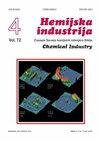基于阴极材料ICP-OES/X射线表征的废旧锂离子电池分类
IF 0.8
4区 工程技术
Q4 ENGINEERING, CHEMICAL
引用次数: 4
摘要
近几十年来,锂离子电池(LIBs)的发展使新型集成正极材料的性能得到了提高,并得到了广泛的应用。这种新材料的迅速扩张导致了老式传统材料的大量替代,并增加了两种材料在极其危险的电子废物场址的同时积累,这进一步增加了对其回收的迫切需要。最重要的是,通过这种方式,废lib可以进一步作为锂和钴等贵重金属的重要来源。然而,锂电池回收的关键问题之一是缺乏基于使用的阴极材料的化学成分的精确电池分类/分类。本文采用电感耦合等离子体发射光谱法和x射线衍射法对40个废lib样品的化学成分进行了表征。样品的制备(预处理)包括:放电、拆解、分离主要部件(阴极、阳极和分离器)、从铝箔上分离阴极材料。结果表明,在所研究的市售锂电池中,钴酸锂是最常用的(正极)材料。本文章由计算机程序翻译,如有差异,请以英文原文为准。
Classification of spent Li-ion batteries based on ICP-OES/X-ray characterization of the cathode materials
Development of lithium-ion batteries (LIBs) during the latest decades resulted in improved performances of the new integrated cathode materials and in their wide applications. This rapid expansion of new materials led to the intensive replacement of the old-fashioned, traditional materials and increased a simultaneous accumulation of both kinds of materials at extremely hazardous electronic waste sites, which additionally increased an urgent need for their recycling. Most importantly, in this way, spent LIBs may further serve as a significant source of valuable metals such as Li and cobalt. However, one of the key problems in LIBs recycling is the absence of a precise battery classification/sorting based on the chemical composition of the used cathode material. In this paper, characterization of the cathode material was performed regarding chemical composition of 40 samples of spent LIBs using inductively coupled plasma - optical emission spectrometry and X-ray diffraction. Preparation of the samples, (pretreatment) included: discharging, dismantling, separation of the main components (cathode, anode and the separator), and detachment of the cathode material from the aluminium foil. The obtained results showed that, in the investigated commercially available LIBs, lithium cobalt oxide was the most frequently used (cathode) material.
求助全文
通过发布文献求助,成功后即可免费获取论文全文。
去求助
来源期刊

Hemijska Industrija
工程技术-工程:化工
CiteScore
1.60
自引率
11.10%
发文量
12
审稿时长
6-12 weeks
期刊介绍:
The Journal Hemijska industrija (abbreviation Hem. Ind.) is publishing papers in the field of Chemical Engineering (Transport phenomena; Process Modeling, Simulation and Optimization; Thermodynamics; Separation Processes; Reactor Engineering; Electrochemical Engineering; Petrochemical Engineering), Biochemical Engineering (Bioreactors; Protein Engineering; Kinetics of Bioprocesses), Engineering of Materials (Polymers; Metal materials; Non-metal materials; Biomaterials), Environmental Engineeringand Applied Chemistry. The journal is published bimonthly by the Association of Chemical Engineers of Serbia (a member of EFCE - European Federation of Chemical Engineering). In addition to professional articles of importance to industry, scientific research papers are published, not only from our country but from all over the world. It also contains topics such as business news, science and technology news, information on new apparatus and equipment, and articles on environmental protection.
 求助内容:
求助内容: 应助结果提醒方式:
应助结果提醒方式:


